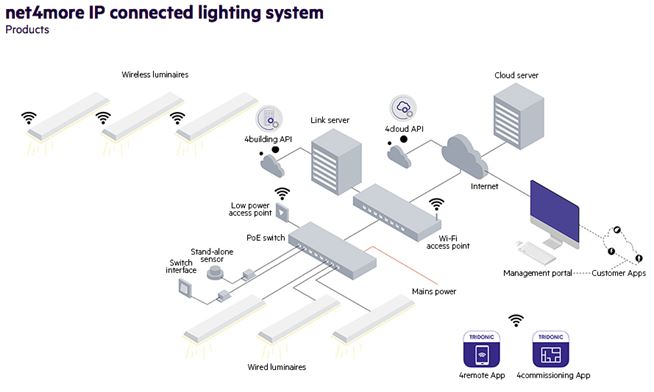Tridonic net4more – Wireless Internet of Light Application
At the company’s headquarters in Dornbirn, Austria, Tridonic installed and connected approximately 300 devices and implemented a smart building system to make it easier for employees to use the building and provide data for building management.
The system is based on Tridonic’s net4more application solution, which is easy to adapt, fully scalable and can be extended as needed. In order to further expand the system, Tridonic researched a suitable wireless solution to meets its requirements.

THE CHALLENGE
The net4more system which Tridonic deployed at its headquarters connects dozens of devices such as luminaires, sensors and presence detectors. It offers an integrated solution for the control of lighting based on an IP infrastructure.
After upgrading the company headquarters to net4more 2.0, the system needed to be extended to cover multiple floors of the building.
Maintenance of such networks, which can be quite large in scale, can present a challenge and is sometimes hard to extend to more remote locations..
There was a clear need for a wireless extension to the system, but without the headaches of introducing yet another protocol and adding complexity and new points of failure. The wireless extension needed to seamlessly integrate into the existing system, with minimal training required for the installers and system integrators to learn how to deploy the solution.
THE PROCESS
Tridonic evaluated solutions that met two main requirements: integration with the existing infrastructure and a simple way to extend the system in terms of reach and scalability.
Using their own headquarters as kind of testing laboratory for net4more they adapted an existing application solution, whereby the connected devices capture data and, for purposes of evaluation and analysis, transmit it to a cloud-based management portal in which the data is visualized. Power is supplied via conventional power cables, powered by DALI or Ethernet (Power over Ethernet/PoE).
While evaluating different solutions, it became clear that many alternatives required additional translation and conversion, eliminating seamless integration with the existing applications. Additionally, many solutions did not offer an easy way to extend coverage of the network since they required multiple access points and repeaters, adding complexity, maintenance and risk of failure.
THE SOLUTION
Tridonic selected Thread due to its native IPv6-based foundation, allowing for the net4more application (based on IP) to be used transparently over a low power wireless network. It is a cost-efficient solution suitable for many applications, and since its low-power, it was optimal for energy constrained devices such as sensors. Furthermore, since Thread uses mesh technology, the reach and quality of the network is enhanced by the IoT devices and lighting products.
The new system allows employees to benefit from an easily adaptable lighting solution which can be controlled using the net4more app in locations throughout the building. For example, meeting rooms have been equipped with smart touch screen displays where lighting can be operated quickly and intuitively via the net4more app. Additionally, the app, if installed on a smartphone or other mobile device, provides more flexibility and the ability to customize to meet the needs of the company’s employees.
The Differentiation
While evaluating possible solutions for the extended requirements of the project, Tridonic assessed various wireless protocols.
Whereas Wi-Fi is ubiquitous and transparent to IP-based applications such as net4more, it requires a lot of power that is not suitable for energy-constrained devices like sensors or buttons. Furthermore, W-Fi is not based on a mesh infrastructure so additional care has to be put into making sure it reaches every location.
Since other low-power solutions are not based on IP they require complex translation and extended engineering and management efforts to integrate them into an existing IP infrastructure.
Tridonic found that only Thread addressed all of the requirements needed for this project.